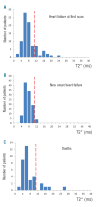International survey of T2* cardiovascular magnetic resonance in β-thalassemia major
- PMID: 23812939
- PMCID: PMC3762092
- DOI: 10.3324/haematol.2013.083634
International survey of T2* cardiovascular magnetic resonance in β-thalassemia major
Abstract
Accumulation of myocardial iron is the cause of heart failure and early death in most transfused thalassemia major patients. T2* cardiovascular magnetic resonance provides calibrated, reproducible measurements of myocardial iron. However, there are few data regarding myocardial iron loading and its relation to outcome across the world. A survey is reported of 3,095 patients in 27 worldwide centers using T2* cardiovascular magnetic resonance. Data on baseline T2* and numbers of patients with symptoms of heart failure at first scan (defined as symptoms and signs of heart failure with objective evidence of left ventricular dysfunction) were requested together with more detailed information about patients who subsequently developed heart failure or died. At first scan, 20.6% had severe myocardial iron (T2*≤ 10 ms), 22.8% had moderate myocardial iron (T2* 10-20 ms) and 56.6% of patients had no iron loading (T2*>20 ms). There was significant geographical variation in myocardial iron loading (24.8-52.6%; P<0.001). At first scan, 85 (2.9%) of 2,915 patients were reported to have heart failure (81.2% had T2* <10 ms; 98.8% had T2* <20 ms). During follow up, 108 (3.8%) of 2,830 patients developed new heart failure. Of these, T2* at first scan had been less than 10 ms in 96.3% and less than 20 ms in 100%. There were 35 (1.1%) cardiac deaths. Of these patients, myocardial T2* at first scan had been less than 10 ms in 85.7% and less than 20 ms in 97.1%. Therefore, in this worldwide cohort of thalassemia major patients, over 43% had moderate/severe myocardial iron loading with significant geographical differences, and myocardial T2* values less than 10 ms were strongly associated with heart failure and death.
Figures



References
-
- Link G, Pinson A, Hershko C. Iron loading of cultured cardiac myocytes modifies sarcolemmal structure and increases lysosomal fragility. J Lab Clin Med. 1993; 121 (1):127–34 - PubMed
-
- Nienhuis AW, Griffith P, Strawczynski H, Henry W, Borer J, Leon M, et al. Evaluation of cardiac function in patients with thalassemia major. Ann N Y Acad Sci. 1980;344:384–96 - PubMed
-
- Anderson LJ, Holden S, Davis B, Prescott E, Charrier CC, Bunce NH, et al. Cardiovascular T2-star (T2*) magnetic resonance for the early diagnosis of myocardial iron overload. Eur Heart J. 2001; 22(23):2171–9 - PubMed
Publication types
MeSH terms
Grants and funding
LinkOut - more resources
Full Text Sources
Other Literature Sources

